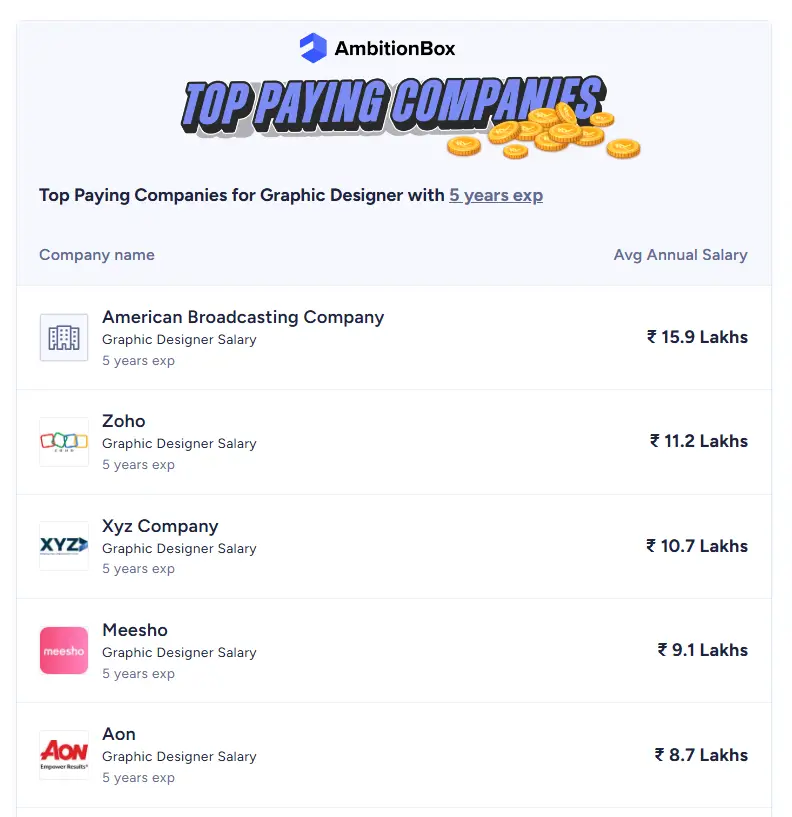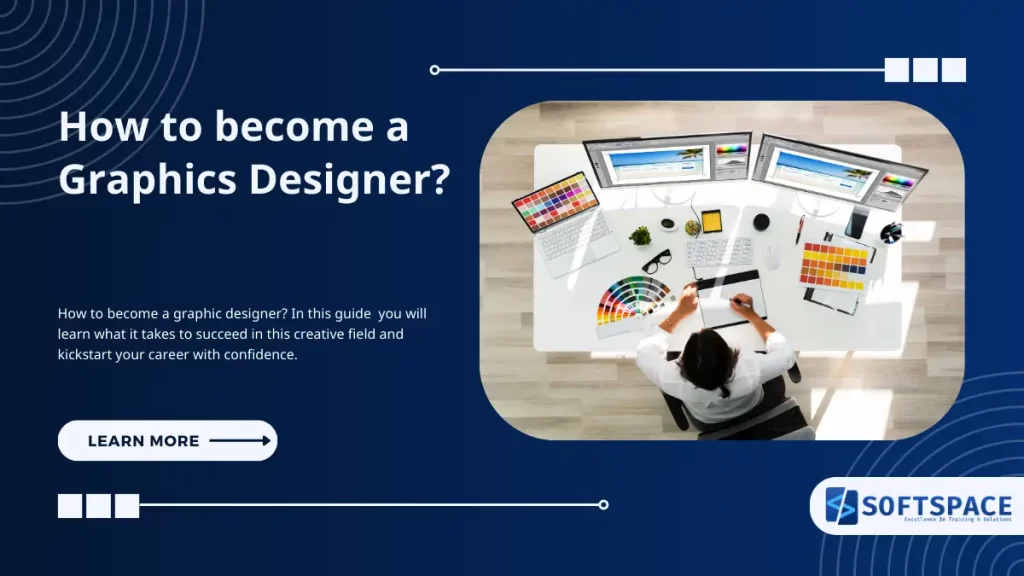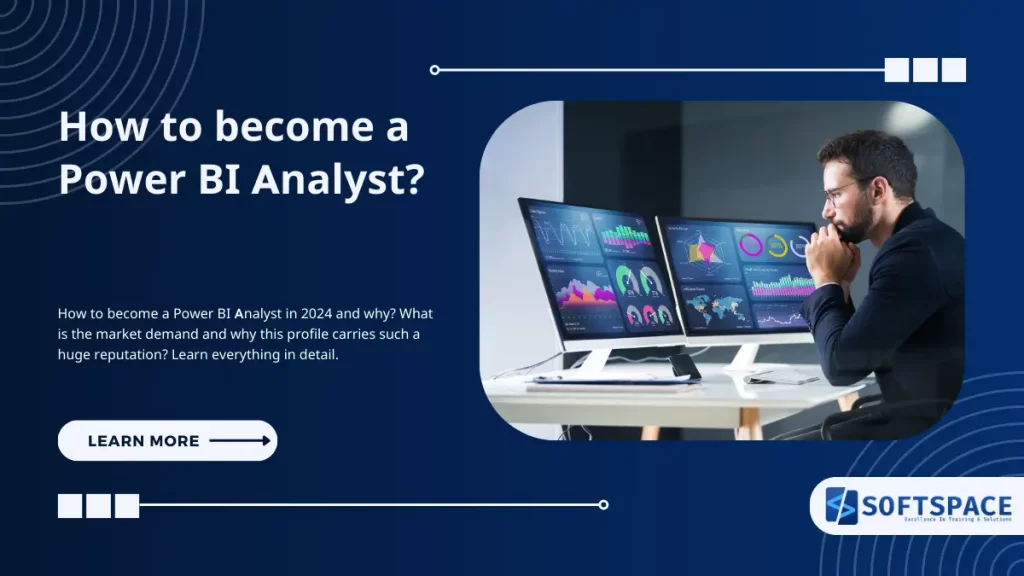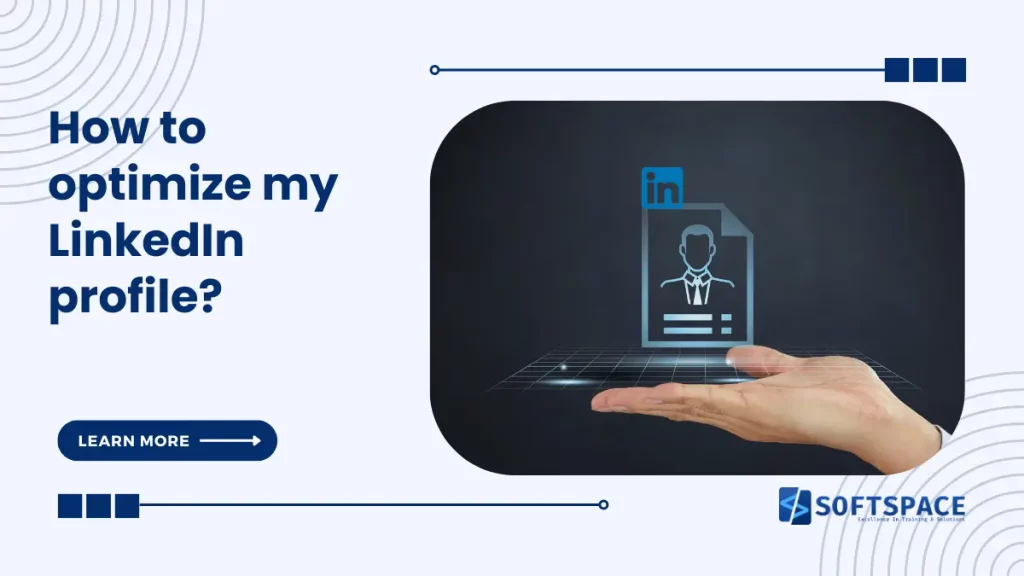In the vibrant world of graphic design, How to become a Graphics Designer in 2024? This question has ushered in an exciting blend of traditional artistry and cutting-edge technology. Whether you’re doodling in notebooks, creating digital masterpieces, or simply fancy turning your creative passion into a fulfilling career, there’s never been a more fascinating time to dive into graphic design.
Gone are the days when graphic designers were solely “Photoshop wizards” hunched over their desks. Today’s design landscape is a dynamic playground where artificial intelligence mingles with human creativity, and social media shapes visual trends at the speed of a scroll.
From crafting eye-catching Instagram stories to designing immersive brand experiences, graphic designers are the unsung heroes behind the visual feast we consume daily.
But here’s the brilliant bit – you don’t need to be a born artist to thrive in this field. What you do need is a keen eye for detail, a willingness to learn, and most importantly, the right set of skills to navigate this ever-evolving industry.
Whether you’re a complete beginner or looking to polish your existing talents, we’ll walk you through the 10 essential skills that will help you stand out in the graphic design world of 2024.
So, pop the kettle on, grab your favourite biscuits, and let’s explore How to become a Graphics Designer. Trust me, by the end of this guide, you’ll have a clear roadmap to kickstart your journey into this colourful profession.
Ready to embark on this exciting adventure? Let’s dive in!

How to become a Graphics Designer with core tech skills?
Adobe Creative Suite Mastery
At the heart of modern graphic design lies Adobe’s powerful suite of tools. Photoshop enables you to transform and enhance images with pixel-perfect precision, while Illustrator lets you create scalable vector graphics for logos and illustrations.
InDesign is your go-to for crafting professional publications and marketing materials, and Adobe XD helps you design seamless user interfaces for digital platforms. Mastering these tools opens endless creative possibilities.
Digital Illustration
Digital illustration has revolutionised the art world, replacing traditional pen and paper with tablets and styluses. Understanding pressure sensitivity, layering, and digital brushwork is crucial.
You’ll need to grasp fundamental principles like perspective, composition, and form while developing skills in character design and concept art. These foundations help bring your creative visions to life digitally.
Typography
Typography is the art and science of text that speaks volumes. It’s about choosing fonts that tell stories and pairing them harmoniously to create visual impact. Understanding hierarchy ensures your message is clear and digestible, while custom lettering adds unique personality to designs.
Knowledge of font licensing is crucial – it keeps you professional and legal. Mastering typography transforms simple text into powerful communication tools.
Colour Theory and Application
Colours evoke emotions and shape perceptions. Understanding colour psychology helps you influence mood and behaviour through your designs. Creating harmonious colour schemes and managing brand colours ensures consistency across platforms.
Crucially, considering accessibility means designing for everyone – including those with colour blindness or visual impairments. This knowledge helps create inclusive, impactful designs.
Layout Design
Layout design is about creating order from chaos. Grid systems provide structure and consistency, while visual hierarchy guides viewers through your content effortlessly. Mastering white space – the ‘breathing room’ in designs – creates balance and elegance.
Understanding responsive design principles ensures your layouts work beautifully across all screen sizes, from mobile phones to desktop monitors, providing seamless user experiences.
Tools you should know to become a Graphics Designer
- Design Software Essentials
- Adobe Creative Cloud
- Photoshop (image editing/manipulation)
- Illustrator (vector graphics)
- InDesign (publishing/layout)
- XD (UI/UX design)
- After Effects (motion graphics)
- Alternative Design Software
- Figma (UI/UX, collaboration)
- Sketch (digital design, Mac only)
- Affinity Suite (cheaper Adobe alternative)
- Affinity Designer
- Affinity Photo
- Affinity Publisher
- Canva (beginner-friendly)
- Digital Art Tools
- Hardware
- Drawing tablets (Wacom, XP-Pen, Huion)
- iPad Pro with Apple Pencil
- Microsoft Surface Pro
- High-resolution monitor
- Colour calibration tools
- Prototyping Tools
- InVision
- Prototype in Figma
- ProtoPie
- Marvel
- Framer
- AI Design Tools
- Midjourney
- DALL-E
- Adobe Firefly
- Runway ML
- Leonardo.ai
- Project Management Tools
- Trello
- Asana
- Monday.com
- Notion
- Google Workspace
- File Management & Collaboration
- Dropbox
- Google Drive
- Creative Cloud Storage
- GitHub (for version control)
- WeTransfer (file sharing)
- Font Management
- Adobe Fonts
- Google Fonts
- FontBase
- Suitcase Fusion
- FontExplorer X Pro
- Colour Tools
- Adobe Color
- Coolors
- Colorhunt
- Pantone Connect
- Colour Contrast Analyzer
- Portfolio Platforms
- Behance
- Dribbble
- WordPress
- Squarespace
- Wix
- Learning Resources
- Online Platforms
- LinkedIn Learning
- Udemy
- Skillshare
- YouTube tutorials
- Domestika
- Design Resource Libraries
- Unsplash (free stock photos)
- Freepik
- Flaticon
- Icons8
- Creative Market
- Mockup Tools
- Smartmockups
- Placeit
- Mockupworld
- Adobe Dimension
- Figma plugins
Why should you become a graphics designer?
Career Opportunities & Growth Potential
- Industry Demand
- The growing digital presence of businesses
- Increase in startups needing branding
- Rise of social media marketing
- E-commerce boom requires product designers
- Growing need for UI/UX designers
- Versatile Career Paths
- Brand Designer
- UI/UX Designer
- Motion Graphics Designer
- Social Media Designer
- Package Designer
- Book/Editorial Designer
- Game Designer
- Freelance Designer
- Design Educator
Graphics Designer Salary in India (5+ Years Experience)

- Entry Level (0-2 years)
- Junior Graphic Designer: ₹15,000 – ₹25,000/month
- UI Designer (Fresher): ₹20,000 – ₹35,000/month
- Social Media Designer: ₹18,000 – ₹30,000/month
- Mid Level (2-5 years)
- Senior Graphic Designer: ₹35,000 – ₹65,000/month
- Brand Designer: ₹45,000 – ₹80,000/month
- UI/UX Designer: ₹50,000 – ₹90,000/month
- Motion Designer: ₹40,000 – ₹75,000/month
- Senior Level (5+ years)
- Art Director: ₹80,000 – ₹1,50,000/month
- Creative Director: ₹1,20,000 – ₹2,50,000/month
- Design Manager: ₹1,00,000 – ₹2,00,000/month
- Freelance Opportunities
- Logo Design: ₹5,000 – ₹50,000 per project
- Website Design: ₹15,000 – ₹1,50,000 per project
- Brand Identity: ₹25,000 – ₹2,00,000 per project
- Social Media Packages: ₹10,000 – ₹50,000 per month
Additional Benefits
- Creative Satisfaction
- Express creativity daily
- Solve visual problems
- Create lasting impact through design
- Work Flexibility
- Remote work opportunities
- Freelance possibilities
- Flexible working hours
- Work-life balance
- Global Opportunities
- International clients
- Remote work for foreign companies
- Higher pay scales
- Exposure to global trends
- Low Initial Investment
- Basic computer/laptop
- Design software
- Internet connection
- Drawing tablet (optional)
- Continuous Learning
- Evolving industry
- New tools and technologies
- Growing skill set
- Regular upskilling opportunities
Modern Design Requirements
UI/UX Design Fundamentals
Modern graphic designers must understand how users interact with digital interfaces. This means mastering user interface principles that create intuitive, enjoyable experiences.
Responsive web design ensures your work looks stunning on any device, while a mobile-first approach acknowledges our smartphone-centric world. Prototyping skills let you test and refine designs before they go live, saving time and resources whilst delivering better user experiences.
Motion Design
Static designs are making way for dynamic, moving content. Understanding animation principles – from timing to easing – brings designs to life. After Effects expertise allows you to create professional animations, whilst mastering social media motion graphics helps capture attention in crowded feeds.
Animated logos and branding elements add that extra dimension to corporate identities, making brands more memorable in today’s digital landscape.
AI Design Tools
The design landscape is being transformed by AI tools. Familiarising yourself with platforms like Midjourney and DALL-E isn’t just trendy – it’s essential for staying competitive. Learning to integrate these tools into your workflow can speed up mundane tasks and spark creative inspiration.
The key is finding the sweet spot between AI assistance and human creativity, using technology to enhance rather than replace your artistic vision.
Professional Skills
Project Management
Success in graphic design isn’t just about creative talent – it’s about managing projects effectively. Clear client communication ensures expectations are met and feedback is properly implemented. Efficient time management helps you meet deadlines without burning out.
Proper file organisation and version control keep your work structured and retrievable. Budget management skills ensure projects remain profitable whilst delivering value to clients.
Business and Marketing
In today’s competitive design world, being a brilliant designer isn’t enough – you need to be business-savvy too. Building a strong personal brand helps you stand out, while a well-curated portfolio showcases your best work.
A strategic social media presence keeps you visible and relevant. Understanding pricing strategies ensures you’re paid fairly, and networking skills help you build valuable relationships that lead to exciting opportunities.
How to become a Graphics Designer & Why you should?
Graphic design is a promising career choice in today’s digital age. With businesses increasingly focusing on visual communication, there’s a growing demand for skilled designers.
The field offers creative freedom, flexible work options (including remote and freelance), and multiple career paths from branding to UI/UX design. Starting salaries range from ₹15,000 to ₹25,000 monthly in India, potentially reaching ₹1,50,000+ with experience.
However, success requires continuous learning, adaptability to new technologies (including AI), and strong client management skills. While the market is competitive, those who combine creativity with business acumen and stay updated with trends can build rewarding, sustainable careers.
The low entry barriers and potential for global opportunities make it an attractive choice for creative individuals.
Conclusion: How to Become a Graphics Designer?
The journey to becoming a graphics designer is both exciting and challenging, but with the right mindset and tools, it’s an achievable goal for anyone passionate about visual creativity. Whether you’re starting from scratch or transitioning from another field, remember that every successful designer started exactly where you are now.
The path to becoming a graphics designer isn’t just about mastering software or following design trends. It’s about developing a unique creative voice, building a stunning portfolio, and continuously adapting to new technologies.
From learning the Adobe Creative Suite to understanding AI design tools, each skill you acquire adds another layer to your professional toolkit.
Remember, the design industry rewards those who never stop learning. Start with the basics, practice regularly, build a strong online presence, and don’t be afraid to take on challenging projects. Whether you choose to work for an agency, go freelance, or join a startup, the opportunities are endless for those willing to put in the effort.
Your journey to become a graphics designer is a marathon, not a sprint. Take it one step at a time, celebrate small wins, and stay curious. The design world is waiting for your unique perspective and creativity. So, grab your tablet, fire up your design software, and start creating – your future in graphic design begins now.

13+ Yrs Experienced Career Counsellor & Skill Development Trainer | Educator | Digital & Content Strategist. Helping freshers and graduates make sound career choices through practical consultation. Guest faculty and Digital Marketing trainer working on building a skill development brand in Softspace Solutions. A passionate writer in core technical topics related to career growth.



